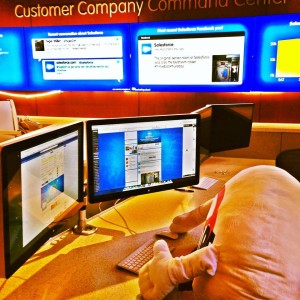 Today, every company is a software company (recent Forbes article) and software is eating the world (entrepreneur Mark Andreessen). The demand for software applications is being driven by the business owners [BO], who historically relied on their internal IT departments who have often failed to deliver on software development projects in a timely or satisfactory manner. These Business owners were first to latch onto SaaS. SaaS not only takes advantage of the ubiquitous web-based client, but is run as a service by the vendor, enabling customers to immediately have access to new capabilities with little up-front investment . These benefits, among others, have enabled SaaS as a category to take share from traditional on-premise software. This ability of SaaS applications to keep up with the requirements of faster-moving business owners have parallels to drivers of cloud infrastructure adoption including agile development.
Today, every company is a software company (recent Forbes article) and software is eating the world (entrepreneur Mark Andreessen). The demand for software applications is being driven by the business owners [BO], who historically relied on their internal IT departments who have often failed to deliver on software development projects in a timely or satisfactory manner. These Business owners were first to latch onto SaaS. SaaS not only takes advantage of the ubiquitous web-based client, but is run as a service by the vendor, enabling customers to immediately have access to new capabilities with little up-front investment . These benefits, among others, have enabled SaaS as a category to take share from traditional on-premise software. This ability of SaaS applications to keep up with the requirements of faster-moving business owners have parallels to drivers of cloud infrastructure adoption including agile development.
The ownership of software development is driving downstream changes in software development and deployment methodologies. SaaS companies have delivered more innovation in a shorter period of time than on-premise competitors and consequently have driven incremental adoption of software. However, SaaS vendors don’t cover the multiplying range of applications that enterprise customers are beginning to demand.
Enterprises face several options in dealing with their current set of applications, which today likely reside in a private data center in a Cloud 1.0-like environment (i.e. virtualized).
Custom Business applications might ultimately never move to the cloud since the cost / benefit economics are less compelling. The cost of re-writing applications for anything other than Cloud 1.0 (which requires minimal if any work) can be very high and traditional enterprises have fewer resources trained to write applications on cloud platforms that are resilient and optimized for the environment of cattle-like servers.
Detriments of SaaS Moving to Cloud
In fact, further evidence of this is the fact that many SaaS companies remain in a Virtualized Web environment. Many of these early SaaS companies began their businesses with a hosting model first or before public cloud resources became commonly available. Products such as Taleo Enterprise Edition, ServiceNow, SAP’s SuccessFactors, and many other SaaS companies were built in a Cloud 1.0 model utilizing traditional virtualization models, traditional relational databases, etc. The fact that these SaaS companies have not re-written for a next generation cloud model underscores the difficulty of adopting a next-generation infrastructure.
SaaS vendors with a Platform-as-a-Service (PaaS) offering form companies such as Google would likely benefit from a quick evolution to Cloud 3.0. Specifically, they might benefit from 1) recognition by enterprises that building Cloud 3.0 is difficult, which might accelerate PaaS adoption over IaaS adoption as a way to minimize the effort in re-writing code; and 2) broader uptake of cloud applications at large that would be complimentary (and possibly integrated with) PaaS applications.
In conclusion, secular growth of software-as-a-service – an Internet-based software delivery model – has been significantly ahead of the overall software market, and we expect this trend to continue.